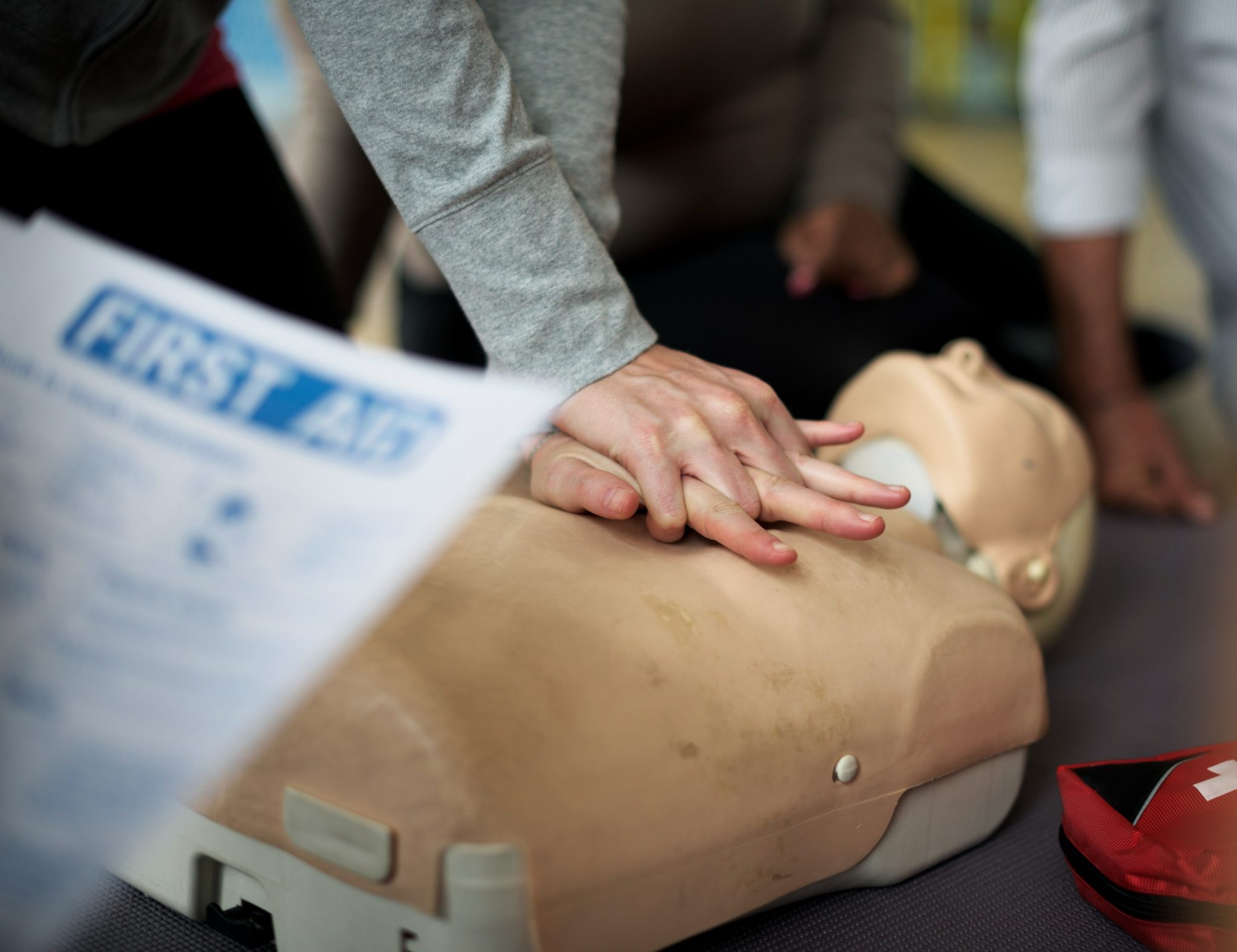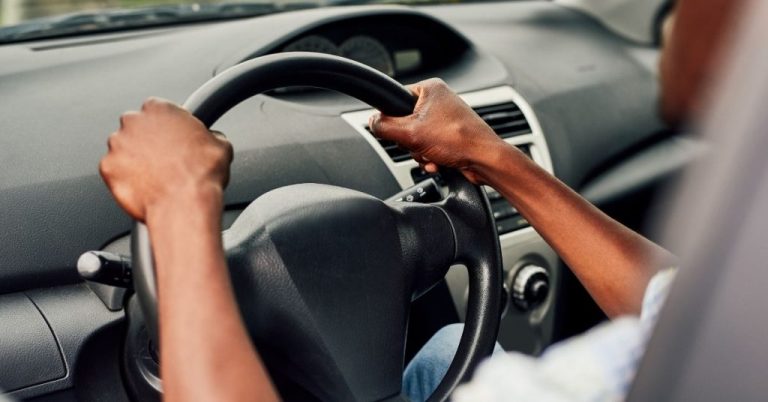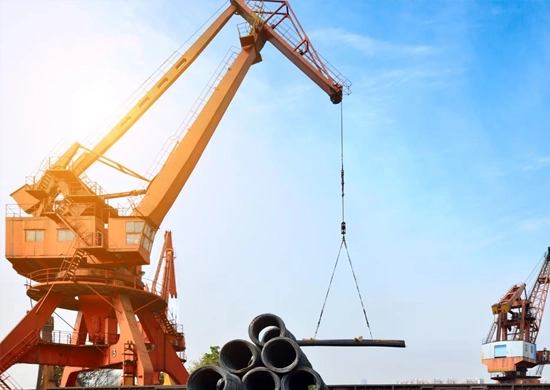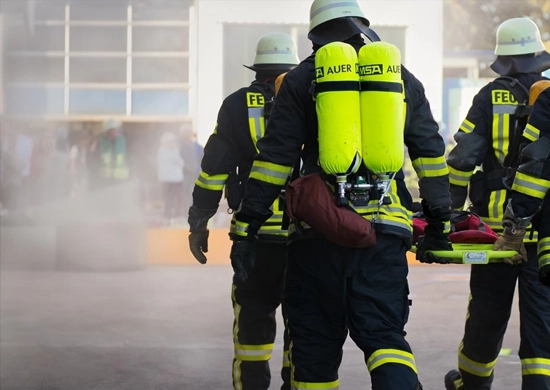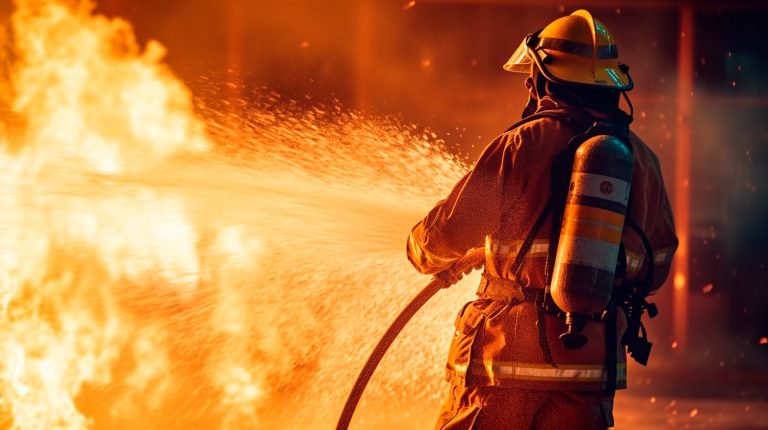Let’s begin with a context-setting example. Picture this: you’re at a family gathering in Riyadh, when suddenly your uncle clutches his chest and slumps to the ground. Panic sets in, people shout for help, but the ambulance is minutes away, too many minutes. In that moment, do you know what to do?!!
That’s where CPR comes in, a simple set of actions that can keep blood pumping and oxygen flowing until professionals arrive. CPR, or cardiopulmonary resuscitation, isn’t just for doctors; it’s a skill anyone can learn, and it can turn you into a lifesaver right there on the spot. At Sustainability Leaders Company (SLC), a leading Health and Safety Training Institute in Saudi Arabia, we see every day how First Aid, CPR, and AED Training empowers ordinary people to step up in emergencies. Whether you’re a construction worker in Jeddah dealing with heat exhaustion or an office employee in Dammam facing a sudden heart attack, this training gives you the tools to act fast and save lives.
It’s scary to think about, but cardiac arrests happen more often than you’d expect. In Saudi Arabia, with our hot climate and busy lifestyles, things like heart issues from stress or dehydration are common. The Red Crescent reports thousands of such cases yearly, and many could be survivable if someone nearby knew CPR. That’s the empowering part, starting CPR within the first few minutes can double survival chances. Add an Automated External Defibrillator (AED), and those odds jump even higher. SLC’s First Aid, CPR, and AED Training teaches you both, blending hands-on practice with real-world scenarios like a collapse at a football match in Riyadh or a choking incident at a wedding in Mecca. It’s not about being a hero; it’s about being prepared, and that’s what makes this training so powerful.
Take Ahmed, an SLC trainee from Khobar. He was at a beach picnic when a friend started choking on food. Ahmed didn’t hesitate; he performed the Heimlich maneuver, then CPR when the friend passed out. Minutes later, the man was breathing again, all because Ahmed had taken our First Aid, CPR, and AED Training just weeks before. Stories like his show how this training turns everyday people into quick thinkers who can save lives in seconds. SLC, one of the top Safety Training Providers in Riyadh, Saudi Arabia, designs our courses to fit local needs, like responding to heat-related emergencies or using AEDs in public spaces.
But empowerment goes beyond the individual. When more people get trained, whole communities become safer. Think about workplaces: a factory in Yanbu where workers know CPR could prevent tragedies from machinery accidents. Or a school in Medina where teachers can handle a student’s asthma attack. SLC’s First Aid, CPR, and AED Training fosters this ripple effect, creating teams that watch out for each other. We also offer Equipment Inspection Services in Saudi Arabia, ensuring AEDs and first aid kits are always ready, so your training translates to real action. In a country pushing forward with Vision 2030, building safer environments starts with skills like these: simple, effective, and life-changing.
Of course, questions come up when people think about starting First Aid, CPR, and AED Training. Let’s break down some key ones to help you see why it’s worth your time.
1. What is the best First Aid, CPR, and AED training course for beginners?
For beginners, the top choice is the American Heart Association’s Heartsaver First Aid CPR AED course. It’s straightforward, no medical background needed, and covers everything from basic wound care to using an AED on a dummy. In Saudi Arabia, SLC offers a version adapted for our climate, like dealing with heatstroke or sand in wounds. It usually takes 4-6 hours, with plenty of practice time so you feel confident. Beginners love it because it’s not overwhelming, with step-by-step instructions, real-life examples like a car accident on a Riyadh highway, and a certification at the end. The Red Cross Basic Life Support is another solid option, but the AHA’s is more hands-on for novices. Cost is affordable, around 200-300 SAR, and it’s valid for two years. If you’re in an office or school, this course is ideal; for construction workers, look for ones with extra focus on trauma. SLC recommends starting here if you’re new; it’s empowering without being scary.
2. Can CPR alone save a life without using an AED?
CPR by itself can save lives, but it’s even better with an AED nearby. CPR keeps blood moving to the brain and organs when the heart stops, buying precious time, up to 10-20 minutes in some cases. Without it, survival drops fast, but studies from the Saudi Heart Association show CPR alone boosts chances by 2-3 times if started right away. In remote areas like the Empty Quarter or during traffic jams in Jeddah, where AEDs might not be handy, CPR is your lifeline. A story from Taif: a hiker revived his friend with chest compressions after a fall, no AED in sight, until rescuers arrived. However, for ventricular fibrillation (a common cause of arrest), CPR maintains the heart’s viability, but an AED’s shock is what restarts normal rhythm. So, while CPR alone works wonders, especially hands-only for untrained people, pairing it with an AED doubles the impact. SLC teaches this balance, emphasizing start CPR first, then grab the AED if possible.
3. How to use an AED correctly in an emergency?
AEDs are designed to be foolproof, but knowing the steps makes you effective. First, ensure the area is safe, no water or metal nearby, and call 112 for help. Turn on the AED; it’ll speak instructions. Expose the person’s chest, dry it if sweaty (common in Saudi summers), and stick the pads, one on the upper right chest, the other lower left. Plug in the connector if needed. The AED analyzes the heart stand clear, no touching the person. If it says “shock advised,” yell “clear!” and press the button. Right after, start CPR for two minutes; the AED will re-check. Keep going until paramedics take over or the person wakes up. Don’t remove pads or turn off the device. In a public spot like a Riyadh airport, AEDs are voice-guided in Arabic and English.
Practice is key, SLC’s sessions let you try on mannequins, so it’s muscle memory. Remember, AEDs won’t shock if not needed, so no harm in trying. This quick process, under a minute, can restart a heart, making you a true lifesaver.
4. What are the 5 basic steps of first aid everyone should know?
First aid boils down to five key steps that anyone can follow. Step one: Stay safe, assess the scene for dangers like fire or traffic before helping, to avoid becoming a victim yourself. In a car crash on a Riyadh road, this means turning on hazards first. Step two: Call for help, dial 112, give your location, and describe the issue. Step three: Check the ABCs, Airway (clear mouth, tilt head), Breathing (look for chest rise), Circulation (feel for pulse). If no breathing, start CPR. Step four: Treat immediate threats, stop heavy bleeding with pressure, immobilize broken bones, or cool burns. For a snake bite in the desert, keep the person calm and still. Step five: Comfort and monitor, reassure them, keep them warm, and watch for changes until help arrives. These steps, from the World Health Organization, are simple but effective. In Saudi Arabia’s varied terrain, from mountains to cities, knowing them means you’re ready for anything, from heat exhaustion to cuts.
5. Why is AED training important even for non-medical professionals?
AED training is vital for non-medical pros because these machines are made for everyday use, and early defibrillation saves lives when pros aren’t around. Cardiac arrest survival plummets 10% per minute without a shock, but AEDs can fix irregular rhythms fast. Non-medics like teachers or drivers are often first responders in a Jeddah beach drowning or a mall heart attack, they’re the ones who can act. Training takes the fear out, teaching pad placement and following prompts, no expertise needed. In Saudi Arabia, with increasing public AEDs in mosques and stadiums, this knowledge turns communities into safety nets. It’s empowering: a shopkeeper in Medina saved a pilgrim with an AED last Hajj. For non-medics, it’s about bridging the gap to ambulances, especially in traffic-heavy cities. SLC pushes this for all, as it boosts survival rates and builds confidence no one should feel helpless in a crisis.
Now, to wrap up some common curiosities, here’s our FAQ on the basics.
FAQ
1. What is First Aid, and why is it important?
First Aid is the quick help given to someone hurt or sick before pros arrive, like bandaging a cut or stabilizing a sprain. It’s important because it stops small problems from getting big, eases pain, and can save lives in serious cases. In Saudi Arabia, with road accidents and heat issues, First Aid cuts response time, improving outcomes. The Saudi Red Crescent says trained people reduce mortality by 50% in emergencies, making it a community essential.
2. What does CPR stand for, and when should it be used?
CPR stands for Cardiopulmonary Resuscitation, a method to restart heart and lung function. Use it when someone’s not breathing or has no pulse, like in drowning or heart attacks. In Saudi Arabia’s pools or during sports, start right after checking responsiveness, call 112 first. It’s for sudden collapses, not gradual illness.
3. What are the steps to perform CPR on an adult?
Start by ensuring safety, then check response, shake, and shout. No answer? Call 112, get an AED. Kneel by them, hands on chest center, push hard (2 inches deep) at 100-120 beats/min—, think “Staying Alive” rhythm. Allow full recoil. If trained, give 2 breaths after 30 pushes. Continue till help arrives. For adults, focus on compressions if unsure about breaths.
4. How do I get certified in CPR and AED?
Enroll in an accredited course like AHA or Red Cross through SLC. It’s 4-8 hours, with practice and a test. In Saudi Arabia, SLC offers sessions in Riyadh, costing 200-400 SAR, valid two years. Many jobs require it; get your card upon passing.
5. Is online CPR and First Aid certification valid?
Online certification is valid if from accredited groups like AHA, but blended (online theory, in-person practice) is best for full acceptance. Pure online might not meet workplace rules in Saudi Arabia, so check with employers. SLC recommends blended for real skills.
In the end, CPR training is about turning fear into action, empowering you to save lives when every minute counts. SLC’s First Aid, CPR, and AED Training is your gateway to that power, tailored for Saudi Arabia’s realities. From urban emergencies to remote incidents, this knowledge makes a difference. With SLC’s expertise and services like Equipment Inspection Services, you’re not just trained, you’re ready. Don’t wait; sign up and become the difference-maker today.

